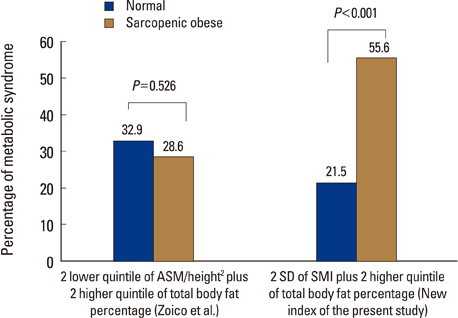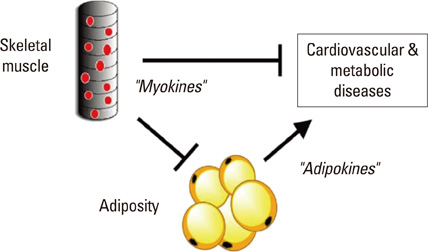Sarcopenia: Definition, Epidemiology, and Pathophysiology
- Affiliations
-
- 1Department of Internal Medicine, Cardiovascular and Metabolic Disease Center, Inje University, Busan, Korea.
- 2Division of Endocrinology and Metabolism, Department of Internal Medicine, College of Medicine, Korea University, Seoul, Korea. medica7@gmail.com
- KMID: 2286306
- DOI: http://doi.org/10.11005/jbm.2013.20.1.1
Abstract
- The epidemiological trends that characterize our generation are the aging of the population. Aging results in a progressive loss of muscle mass and strength called sarcopenia, which is Greek for 'poverty of flesh'. Sarcopenia could lead to functional impairment, physical disability, and even mortality. Today, sarcopenia is a matter of immense public concern for aging prevention. Its prevalence continues to rise, probably as a result of increasing elderly populations all over the world. This paper addressed the definition and epidemiology of sarcopenia and its underlying pathophysiology. In addition, we summarized the abundant information available in the literature related to sarcopenia, together with results from Korean sarcopenic obesity study (KSOS) that we performed.
Keyword
Figure
Cited by 5 articles
-
Relationship between diet quality and sarcopenia in elderly Koreans: 2008–2011 Korea National Health and Nutrition Examination Survey
Woori Na, Jiyu Kim, Bong Hee Chung, Dai-Ja Jang, Cheongmin Sohn
Nutr Res Pract. 2020;14(4):352-364. doi: 10.4162/nrp.2020.14.4.352.Changes of Paraspinal Muscles in Postmenopausal Osteoporotic Spinal Compression Fractures: Magnetic Resonance Imaging Study
Jong Yun Kim, Soo Uk Chae, Gang Deuk Kim, Myoung Soo Cha
J Bone Metab. 2013;20(2):75-81. doi: 10.11005/jbm.2013.20.2.75.Prevalence of Sarcopenia in the Korean Woman Based on the Korean National Health and Nutritional Examination Surveys
Hyoung-Joon Kwon, Yong-Chan Ha, Hyoung-Moo Park
J Bone Metab. 2016;23(1):23-26. doi: 10.11005/jbm.2016.23.1.23.Association between Grip Strength as Diagnostic Criteria of Sarcopenia and Health-Related Quality of Life in Korean Elderly
On Lee, Yeon-Soo Kim
Korean J Sports Med. 2018;36(1):15-23. doi: 10.5763/kjsm.2018.36.1.15.Effect of CCL11 on
In Vitro Myogenesis and Its Clinical Relevance for Sarcopenia in Older Adults
Da Ae Kim, So Jeong Park, Jin Young Lee, Jeoung Hee Kim, Seungjoo Lee, Eunju Lee, Il-Young Jang, Hee-Won Jung, Jin Hoon Park, Beom-Jun Kim
Endocrinol Metab. 2021;36(2):455-465. doi: 10.3803/EnM.2020.942.
Reference
-
1. Rosenberg IH, Roubenoff R. Stalking sarcopenia. Ann Intern Med. 1995. 123:727–728.
Article2. Cesari M, Leeuwenburgh C, Lauretani F, et al. Frailty syndrome and skeletal muscle: results from the Invecchiare in Chianti study. Am J Clin Nutr. 2006. 83:1142–1148.
Article3. Riechman SE, Schoen RE, Weissfeld JL, et al. Association of physical activity and visceral adipose tissue in older women and men. Obes Res. 2002. 10:1065–1073.
Article4. Ryan AS, Nicklas BJ. Age-related changes in fat deposition in mid-thigh muscle in women: relationships with metabolic cardiovascular disease risk factors. Int J Obes Relat Metab Disord. 1999. 23:126–132.
Article5. Stenholm S, Harris TB, Rantanen T, et al. Sarcopenic obesity: definition, cause and consequences. Curr Opin Clin Nutr Metab Care. 2008. 11:693–700.
Article6. Grimby G, Saltin B. The ageing muscle. Clin Physiol. 1983. 3:209–218.
Article7. Hughes VA, Frontera WR, Wood M, et al. Longitudinal muscle strength changes in older adults: influence of muscle mass, physical activity, and health. J Gerontol A Biol Sci Med Sci. 2001. 56:B209–B217.
Article8. Goodpaster BH, Park SW, Harris TB, et al. The loss of skeletal muscle strength, mass, and quality in older adults: the health, aging and body composition study. J Gerontol A Biol Sci Med Sci. 2006. 61:1059–1064.
Article9. Janssen I, Shepard DS, Katzmarzyk PT, et al. The healthcare costs of sarcopenia in the United States. J Am Geriatr Soc. 2004. 52:80–85.
Article10. Korea S. Population Projections for Korea. 2010. cited by 2010 December 31. Available from: http://www.index.go.kr/egams/stts/jsp/potal/stts/PO_STTS_IdxMain.jsp?idx_cd=1009&bbs=INDX_001.11. Abellan van Kan G. Epidemiology and consequences of sarcopenia. J Nutr Health Aging. 2009. 13:708–712.
Article12. Baumgartner RN, Koehler KM, Gallagher D, et al. Epidemiology of sarcopenia among the elderly in New Mexico. Am J Epidemiol. 1998. 147:755–763.
Article13. Heymsfield SB, Smith R, Aulet M, et al. Appendicular skeletal muscle mass: measurement by dual-photon absorptiometry. Am J Clin Nutr. 1990. 52:214–218.
Article14. Wang ZM, Visser M, Ma R, et al. Skeletal muscle mass: evaluation of neutron activation and dual-energy X-ray absorptiometry methods. J Appl Physiol. 1996. 80:824–831.
Article15. Janssen I, Heymsfield SB, Ross R. Low relative skeletal muscle mass (sarcopenia) in older persons is associated with functional impairment and physical disability. J Am Geriatr Soc. 2002. 50:889–896.
Article16. Newman AB, Kupelian V, Visser M, et al. Sarcopenia: alternative definitions and associations with lower extremity function. J Am Geriatr Soc. 2003. 51:1602–1609.
Article17. Delmonico MJ, Harris TB, Lee JS, et al. Alternative definitions of sarcopenia, lower extremity performance, and functional impairment with aging in older men and women. J Am Geriatr Soc. 2007. 55:769–774.
Article18. Visser M, Kritchevsky SB, Goodpaster BH, et al. Leg muscle mass and composition in relation to lower extremity performance in men and women aged 70 to 79: the health, aging and body composition study. J Am Geriatr Soc. 2002. 50:897–904.
Article19. Ochi M, Kohara K, Tabara Y, et al. Arterial stiffness is associated with low thigh muscle mass in middle-aged to elderly men. Atherosclerosis. 2010. 212:327–332.
Article20. Ochi M, Tabara Y, Kido T, et al. Quadriceps sarcopenia and visceral obesity are risk factors for postural instability in the middle-aged to elderly population. Geriatr Gerontol Int. 2010. 10:233–243.
Article21. Janssen I, Baumgartner RN, Ross R, et al. Skeletal muscle cutpoints associated with elevated physical disability risk in older men and women. Am J Epidemiol. 2004. 159:413–421.
Article22. Cruz-Jentoft AJ, Baeyens JP, Bauer JM, et al. Sarcopenia: European consensus on definition and diagnosis: Report of the European Working Group on Sarcopenia in Older People. Age Ageing. 2010. 39:412–423.
Article23. Mokdad AH, Bowman BA, Ford ES, et al. The continuing epidemics of obesity and diabetes in the United States. JAMA. 2001. 286:1195–1200.
Article24. Roubenoff R. Sarcopenic obesity: the confluence of two epidemics. Obes Res. 2004. 12:887–888.
Article25. Melton LJ 3rd, Khosla S, Crowson CS, et al. Epidemiology of sarcopenia. J Am Geriatr Soc. 2000. 48:625–630.
Article26. Baumgartner RN, Wayne SJ, Waters DL, et al. Sarcopenic obesity predicts instrumental activities of daily living disability in the elderly. Obes Res. 2004. 12:1995–2004.
Article27. Aubertin-Leheudre M, Lord C, Goulet ED, et al. Effect of sarcopenia on cardiovascular disease risk factors in obese postmenopausal women. Obesity (Silver Spring). 2006. 14:2277–2283.
Article28. Kim TN, Yang SJ, Yoo HJ, et al. Prevalence of sarcopenia and sarcopenic obesity in Korean adults: the Korean sarcopenic obesity study. Int J Obes (Lond). 2009. 33:885–892.
Article29. Kim TN, Park MS, Lim KI, et al. Skeletal muscle mass to visceral fat area ratio is associated with metabolic syndrome and arterial stiffness: The Korean Sarcopenic Obesity Study (KSOS). Diabetes Res Clin Pract. 2011. 93:285–291.
Article30. Evans WJ, Campbell WW. Sarcopenia and age-related changes in body composition and functional capacity. J Nutr. 1993. 123:465–468.
Article31. Malafarina V, Uriz-Otano F, Iniesta R, et al. Sarcopenia in the elderly: diagnosis, physiopathology and treatment. Maturitas. 2012. 71:109–114.
Article32. Lang T, Streeper T, Cawthon P, et al. Sarcopenia: etiology, clinical consequences, intervention, and assessment. Osteoporos Int. 2010. 21:543–559.
Article33. Ramírez V, Ulfhake B. Anatomy of dendrites in motoneurons supplying the intrinsic muscles of the foot sole in the aged cat: evidence for dendritic growth and neo-synaptogenesis. J Comp Neurol. 1992. 316:1–16.
Article34. Kullberg S, Ramírez-León V, Johnson H, et al. Decreased axosomatic input to motoneurons and astrogliosis in the spinal cord of aged rats. J Gerontol A Biol Sci Med Sci. 1998. 53:B369–B379.
Article35. Doherty TJ, Vandervoort AA, Brown WF. Effects of ageing on the motor unit: a brief review. Can J Appl Physiol. 1993. 18:331–358.
Article36. Doherty TJ, Vandervoort AA, Taylor AW, et al. Effects of motor unit losses on strength in older men and women. J Appl Physiol. 1993. 74:868–874.
Article37. Boirie Y. Physiopathological mechanism of sarcopenia. J Nutr Health Aging. 2009. 13:717–723.
Article38. Zadik Z, Chalew SA, McCarter RJ Jr, et al. The influence of age on the 24-hour integrated concentration of growth hormone in normal individuals. J Clin Endocrinol Metab. 1985. 60:513–516.
Article39. Rudman D, Feller AG, Nagraj HS, et al. Effects of human growth hormone in men over 60 years old. N Engl J Med. 1990. 323:1–6.
Article40. Papadakis MA, Grady D, Black D, et al. Growth hormone replacement in healthy older men improves body composition but not functional ability. Ann Intern Med. 1996. 124:708–716.
Article41. Brotto M, Abreu EL. Sarcopenia: pharmacology of today and tomorrow. J Pharmacol Exp Ther. 2012. 343:540–546.
Article42. Nass R, Thorner MO. Impact of the GH-cortisol ratio on the age-dependent changes in body composition. Growth Horm IGF Res. 2002. 12:147–161.
Article43. Visser M, Deeg DJ, Lips P. Low vitamin D and high parathyroid hormone levels as determinants of loss of muscle strength and muscle mass (sarcopenia): the Longitudinal Aging Study Amsterdam. J Clin Endocrinol Metab. 2003. 88:5766–5772.
Article44. Kim TN, Park MS, Lim KI, et al. Relationships between sarcopenic obesity and insulin resistance, inflammation, and vitamin D status: the Korean Sarcopenic Obesity Study. Clin Endocrinol (Oxf). 2013. 78:525–532.
Article45. Recker R, Lips P, Felsenberg D, et al. Alendronate with and without cholecalciferol for osteoporosis: results of a 15-week randomized controlled trial. Curr Med Res Opin. 2006. 22:1745–1755.
Article46. Rasmussen BB, Fujita S, Wolfe RR, et al. Insulin resistance of muscle protein metabolism in aging. FASEB J. 2006. 20:768–769.
Article47. Sayer AA, Syddall HE, Dennison EM, et al. Grip strength and the metabolic syndrome: findings from the Hertfordshire Cohort Study. QJM. 2007. 100:707–713.
Article48. Park SW, Goodpaster BH, Strotmeyer ES, et al. Accelerated loss of skeletal muscle strength in older adults with type 2 diabetes: the health, aging, and body composition study. Diabetes Care. 2007. 30:1507–1512.
Article49. Kim TN, Park MS, Yang SJ, et al. Prevalence and determinant factors of sarcopenia in patients with type 2 diabetes: the Korean Sarcopenic Obesity Study (KSOS). Diabetes Care. 2010. 33:1497–1499.
Article50. Thomas DR. Sarcopenia. Clin Geriatr Med. 2010. 26:331–346.
Article51. Honda H, Qureshi AR, Axelsson J, et al. Obese sarcopenia in patients with end-stage renal disease is associated with inflammation and increased mortality. Am J Clin Nutr. 2007. 86:633–638.
Article52. Schrager MA, Metter EJ, Simonsick E, et al. Sarcopenic obesity and inflammation in the InCHIANTI study. J Appl Physiol. 2007. 102:919–925.
Article53. Stenholm S, Rantanen T, Heliövaara M, et al. The mediating role of C-reactive protein and handgrip strength between obesity and walking limitation. J Am Geriatr Soc. 2008. 56:462–469.
Article54. Pedersen BK, Edward F. Adolph distinguished lecture: muscle as an endocrine organ: IL-6 and other myokines. J Appl Physiol. 2009. 107:1006–1014.
Article55. Pedersen BK. The diseasome of physical inactivity--and the role of myokines in muscle--fat cross talk. J Physiol. 2009. 587:5559–5568.
Article56. Walsh K. Adipokines, myokines and cardiovascular disease. Circ J. 2009. 73:13–18.
Article57. Arnold AS, Egger A, Handschin C. PGC-1alpha and myokines in the aging muscle - a mini-review. Gerontology. 2011. 57:37–43.
Article58. Zamboni M, Mazzali G, Fantin F, et al. Sarcopenic obesity: a new category of obesity in the elderly. Nutr Metab Cardiovasc Dis. 2008. 18:388–395.
Article59. Clark BC, Manini TM. Sarcopenia =/= dynapenia. J Gerontol A Biol Sci Med Sci. 2008. 63:829–834.
Article60. Nair KS. Aging muscle. Am J Clin Nutr. 2005. 81:953–963.
Article61. Roubenoff R. Catabolism of aging: is it an inflammatory process? Curr Opin Clin Nutr Metab Care. 2003. 6:295–299.
Article62. Buford TW, Anton SD, Judge AR, et al. Models of accelerated sarcopenia: critical pieces for solving the puzzle of age-related muscle atrophy. Ageing Res Rev. 2010. 9:369–383.
Article
- Full Text Links
- Actions
-
Cited
- CITED
-
- Close
- Share
- Similar articles
-
- Diabetes and Sarcopenia
- Multidisciplinary approach to sarcopenia: a narrative review
- Review of Epidemiology, Diagnosis, and Treatment of Osteosarcopenia in Korea
- Corrigendum to “Determination of normative reference for the definition of sarcopenia among Filipinos†[Osteoporos. Sarcopenia 2 (2016) 186–190]
- Current Status of Sarcopenia in Korea: A Focus on Korean Geripausal Women




